What Metro 2025 Means to Maryland
Metro 2025 would bring significant benefits to Maryland, supporting its economic growth and ensuring its future vitality.
Metro’s Momentum plan calls for seven Metro 2025 initiatives – from eight-car trains to bus-only lanes, which will bring dramatic improvements to the quality of life and transportation to Maryland.
Ensures the Success of Maryland Transit Projects
Maryland has great plans for transit. The Corridor Cities Transitway, the Purple Line, and the Viers Mill Rd Busway are all included in the CLRP with a reasonable expectation for funding, and the Federal Transit Administration announced recently that the Purple Line would receive $100 million in Obama’s latest FY15 budget. Additionally, Montgomery County is developing plans for a county-wide BRT system.
These projects are worthwhile ventures, but they will always rely on the supporting regional “backbone” of Metrorail and Metrobus to deliver their intended results. At the very least, these three important projects would not connect to each other if not for Metrorail and Metrobus. And at the very worst, if these projects are built and connect to a system that is already over capacity, they may struggle to live up to their mobility goals.
- The Corridor Cities Transitway will function as a BRT extension of the Red Line: 1,500 people per peak hour will transfer to Metrorail at Shady Grove by 2030. (For context, about 3,000 riders per peak hour enter Shady Grove in the peak hour today.)
- The Viers Mill Rd Busway will connect to three Metrorail stations. The current Metrobus Q-Line, a part of the Priority Corridor Network (PCN), currently provides over 8,800 trips per day, including approximately 800 transfers a day to Metrorail.
- 10,000 Purple Line riders per day will come to and from Metrorail, where the Purple Line connects to the Red, Green, and Orange lines. Many of these passengers will further strain the over-congested lines of the rail network.
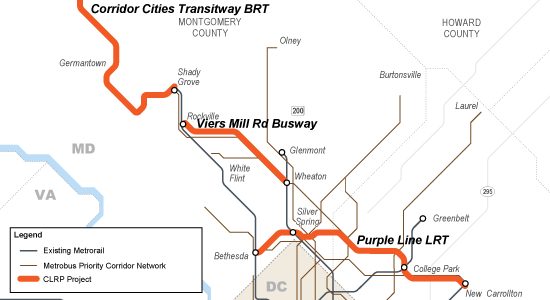
Funded Maryland transit projects, in the CLRP.
By ensuring that Metro services can keep pace with congestion and demand, Metro 2025 is critical to making Maryland’s transit projects a success, and critical to helping the region and the state reach its transportation goals.
![]()
Supports Maryland’s Growth Prospects
Maryland’s population in the Compact region is growing steadily and projected to continue growing. This growth is crucial to the economy of the state – 40% of Maryland’s state economic output came from the Washington region’s suburbs in 2012. With that growth comes significant transportation needs, and Metro 2025 is critical to meeting that growth.
- Since 2000, the population in Montgomery and Prince George’s counties has grown by 12%
- Leading this growth has been Gen Y, who increasingly take public transportation if they even have driver licenses.
- By 2040, suburban Maryland is projected to see an influx of nearly 360,000 jobs (PDF), or an increase of 42%.
When congestion goes up, job growth goes down, and if Maryland wants to see growth potential turn into actual jobs, it needs to tame congestion. Simply, Maryland needs the mobility that Metro 2025 would deliver: 8-car trains capable of moving the equivalent of 16-18 lanes of highways (in each direction) and connect Maryland to other regional job centers, superior bus service that can create much-needed east-west connections that bypass snarling congestion, and more.
Alternatively, if Maryland were to support this growth with highway investments, it could need the equivalent of 296 lane-miles of pavement, including 26 new arterial lanes in each direction through the Montgomery and Prince George’s Counties. This investment in Maryland alone could reach upwards of $1.2 billion.
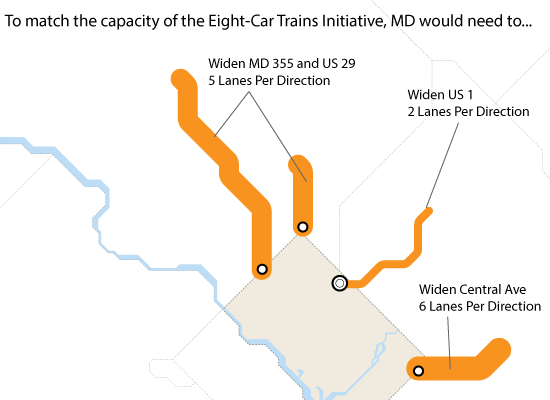
To match the same capacity as Metro 2025, Maryland would have to add 26 lanes of arterial roadways, 13 in each direction.
Relieves Crowding on Trains and Buses
Metrorail and Metrobus are full to capacity, and Maryland residents feel it every day.
- Today, nearly 16,000 Maryland residents each day experience uncomfortably crowded conditions on-board Metrorail, a figure expected to increase 44% to nearly 23,000 Maryland residents by 2025 not even counting the additional riders transferring to Metrorail from new Maryland transit projects.
- Nearly 33,000 Maryland residents each day pass through a crowded Metrorail station – often encountering lines for elevators, escalators, or fare gates.
- At the same time, over 7,700 Maryland residents every day ride a crowded bus.
- Without Metro 2025, crowding on Metrorail is projected to more than double (increase by 113%).
Running all 8-car trains at peak times cuts the number of riders experiencing crowding from 26% to 9%, especially at peak load points such as: Navy Yard, Mt. Vernon Square, Dupont Circle, Gallery Place, and Foggy Bottom.
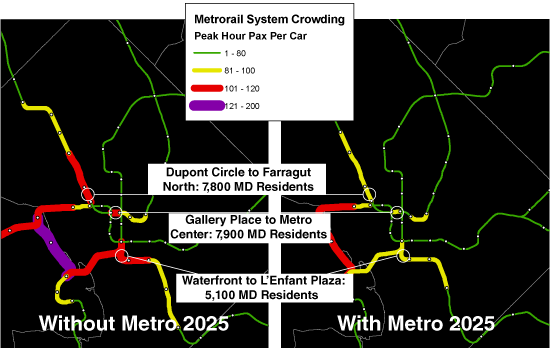
Metro 2025 will relieve significant crowding for over 23,000 Maryland residents at peak load points on-board Metrorail during the peak hour in 2025.
Saves Time and Money for Maryland Riders and Drivers Alike
By simultaneously taking tens of thousands of cars off the road and improving transit, Metro 2025 saves time for both transit riders and drivers.
- Metro 2025 takes almost 20,000 cars off Maryland roads every day, reducing traffic jams and air pollution
- Maryland residents would enjoy buses that move faster, and Metrorail riders will move faster through the system due to less station congestion. This will save Maryland residents time worth $66 million per year.
- Maryland riders and drivers alike would save another $50 million per year in out-of-pocket travel costs like gas and car maintenance.
![]()
Reduces Costs to Maryland
Metro 2025 will make Metro more efficient, allowing us to reinvest the savings in more service, or reduce the subsidy required from our funding partners.
- For example, the Metrobus Priority Corridor Network could increase bus speeds by up to 50% on some routes, saving over $1.6 million in annual operating costs for Maryland’s share of the PCN routes.
- Eight-car trains and station capacity improvements may translate into real savings by avoiding the costs of delays caused by crowding in the future. If Metro 2025 prevents increases in trains dwell times, this could prevent an increase in peak operating costs of up to ten percent for Metrorail. This would equal avoiding a subsidy increase of over $2.2 million per year for the State of Maryland. Additionally, if the improvements in travel speed can reduce our peak rail vehicle requirement by up to 32 rail cars, this could translate into in a one-time savings of up to $23 million for Maryland.
Makes Metro More Reliable
Finally, Metro 2025 makes Metro a more reliable transit system. Pocket tracks and crossovers would allow Metrorail to better match rail service with demand. For maintenance, this special trackwork would allow us to more effectively operate around planned work. Buses in their own lane with signal priority allows us to better maintain bus spacing and keep pace with the impacts from traffic congestion.

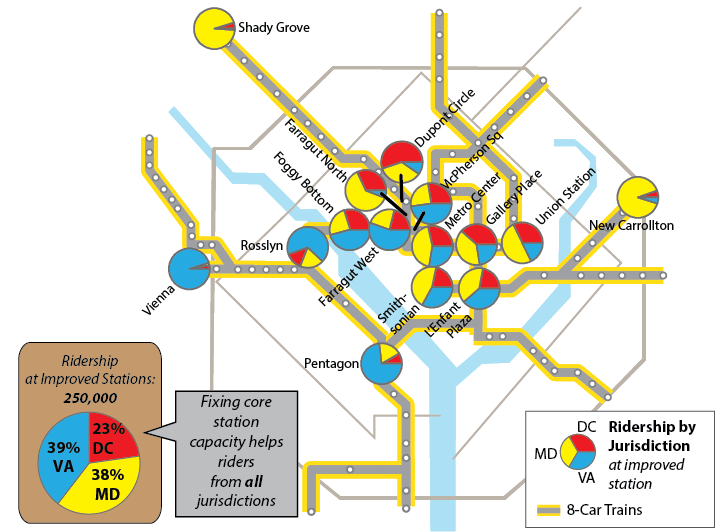
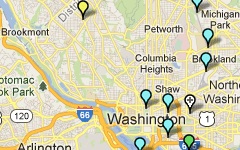
Has there been any talk about connecting the Red Line between Silver Spring and Twinbrook paralleling MARC? I’m just curious about commuting patterns in this area between MoCo and PG counties and if it makes sense to have a higher frequency surburban rail option.
If overcrowding is an issue in 2014, imagine what it will be like if DC changes the height limits and more businesses and residents move into the District.